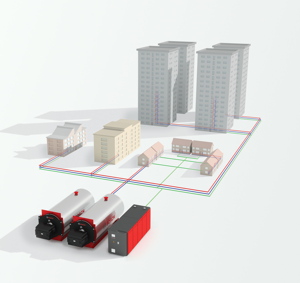By luck or by design: getting heat networks right

With no two heat networks ever the same, well-planned design and installation are crucial to ensuring a system performs to its potential. Pete Mills explains the top considerations for consultants embarking on a district heating project.
The number of district heating schemes in the UK is set to grow exponentially in the coming years as a result of new funding initiatives. The Department for Business, Energy and Industrial Strategy (BEIS) launched a £39 million Heat Networks Investment Project in 2016. It awarded £24 million for nine district heat network infrastructure projects in April this year, while public funding is predicted to generate up to £2bn in new heat network infrastructure investments across the country. It is projected that heat networks could deliver up to 18 per cent of UK heating demand by 2030, according to the Committee on Climate Change.
In response to the growth in the technology’s usage here in the UK, a host of organisations have outlined a series of guidance documents and best practises for heat networks; some of which lack the technical detail needed for effective application. In part this is due to the nature of district heating systems, for which there cannot be a one size fits all approach.
 |
| It is important to review the system design criteria to deliver the required comfort levels. |
Understanding how each of the parameters impact the design and implementation of a heat network system, as well as the shortfalls of some current practises, is crucial. By taking into account a series of key considerations from the outset, consultants and contractors can ensure their heat networks deliver to expected levels of output and performance.
Putting end-users first
For all district heating systems, it is essential that the needs of end-users are considered from the outset. A consistent and accurate approach to billing and convenient pre-payment options are of the utmost importance for users. With district heating systems creating a natural monopoly by their very nature, it is also essential that opt-out functions are in place.
Pre-payment systems which display energy use and remaining credit, ultimately ensure final customers can benefit from greater transparency. It is also important to ensure that residents’ energy will be priced at least in parallel, and ideally lower than, other utilities.
This is where the benefits of renewable energy, waste and low carbon heat sources come in to play. Low carbon energy and renewable heat sources are the only way of ensuring that customers can benefit from reduced fuel bills, but this is too often overlooked. Poor decisions at the early stages of design, which are focussed on compliance with energy targets, can leave end-users compromised with the high energy costs we have seen reported at some poorly-performing schemes.
To this end, the Heat Network Metering and Billing Regulations came into force in 2014. Applicable to all heat networks with two or more final customers who purchase heat, the regulations require heat suppliers to install meters for each final customer, as well as building-level meters. All heat networks must register with the National Measurement and Regulation Office and provide updated notification every four years. The intention is to provide as much transparency as possible for end-users.
 |
| A tailored approach that brings together manufacturers, contractors and designers is important to get the project right for end users. |
Specification
Specifications for district heating systems can often lack the detail for effective implementation. This is a particular problem where clients are not sure what they want from a heat network. Collaboration between manufacturers, contractors and designers can help to tap into collective experience and avoid common pitfalls.
Reviewing the system design criteria is essential for any district heating project to ensure the system delivers the required comfort levels without over-specification. The CIBSE-endorsed Danish DS 439 standard can be used to calculate flow rates for domestic hot water diversification. Working with manufacturers to obtain project-specific data for use in calculations, rather than general data from data sheets, ensures the most effective system design, refined to ensure the minimum pipe sizes are used. It’s essential that the system can adapt to usage from the dead of night to peak bathroom use in the morning, so another key consideration is the development of a strategy for differential pressure control.
Setting the temperature
It has been common practice to store domestic hot water (DHW) at 60°C. Yet the Approved Code of Practice (ACOP) L8 hot water guidance, suggests that for instantaneous water heaters, for example district heating systems using Heat Interface Units (HIU) with a plate heat exchanger, temperatures as low as 50°C can safely be adopted.
This is supported by research in combi boilers, which reveals homeowners often run their boilers at much lower temperatures. Operating at 50°C also helps to ensure the minimum return temperature requirements of Part L for community heating (Domestic Building Services Compliance Guide, section 6) of less than 40°C for DHW and 50°C for radiator heating are met. Selecting HIUs with active return temperature control can further improve performance. Refining design to help minimise network losses by reducing return temperatures, means that older practices of producing DHW at higher temperatures are inappropriate for a heat network using HIUs and producing domestic hot water via plate heat exchangers.
 |
| There cannot be a one-size-fits-all approach to designing of heat networks; but there are points to be considered for each. |
These perceived requirements for high temperatures are largely based on outdated and ineffective stored water systems. Experience in Denmark has shown that stored water adds to overall heat losses, whilst providing no benefit to the resilience of the network design. With confusion over which requirement takes precedence, opting for ACOP L8, with its lower temperature requirements, will ensure the most efficient system.
Insulation
Further reductions in heat losses can be achieved through effective pipe insulation. There is currently little specific guidance in this area aimed at heat networks and our recommendation would be to model the effects of insulation thickness against a whole life cost. As a guiding principle, it is essential that network losses are kept lower than 15% and ideally below 10%. This is another factor which will impact favourably on energy costs for final users.
Overall when it comes to designing and installing heat networks, a fluid approach is needed where the design is continually reviewed and refined, rather than remaining fixed. A tailored approach that brings together manufacturers, contractors and designers, with the needs of end-users at the forefront of consideration is essential to the success of a district heating system.
Pete Mills is Commercial Technical Operations Manager at Bosch Commercial and Industrial







